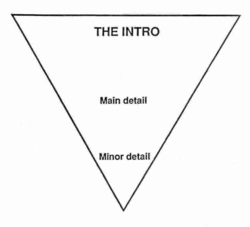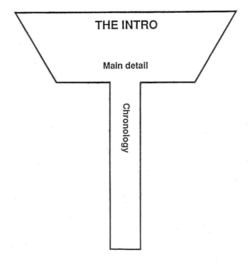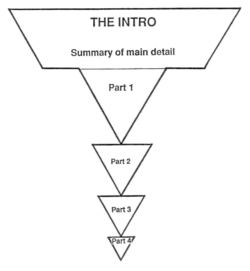In this chapter we build on what we learned in Chapter 3: The shape of the news story. Here we look at more complex stories, and how they are written.
_____________________________________________________________
Review of the inverted pyramid
In Chapter 3, we saw that the basic shape of the news story is the inverted pyramid. This means that the most newsworthy key point comes first in the story, in the intro. This is followed by the other key points, in descending order of newsworthiness, so that the main detail comes first and the minor detail last.
 This is a good basic pattern, and works well for simple news stories. This "shape" of the news story, with a "broad" top and a "narrow" base, is in the weight of the news itself. You can look back at the example, of the Hohola house fire in Chapter 3 to see how the first paragraph of the news story is the biggest news, and how the story begins to taper down towards the minor detail.
This is a good basic pattern, and works well for simple news stories. This "shape" of the news story, with a "broad" top and a "narrow" base, is in the weight of the news itself. You can look back at the example, of the Hohola house fire in Chapter 3 to see how the first paragraph of the news story is the biggest news, and how the story begins to taper down towards the minor detail.
Remember the first paragraph, which is called the intro, contains the most newsworthy part of the story - the newest, most unusual, most interesting and most significant - told clearly and simply. This is followed by a full explanation and all the details. The most newsworthy parts of the story will be written nearest to the top of the story.
The later part of the story - the tapering point of the inverted pyramid - contains detail which is helpful, but not essential.
However, when you have to write a more complex news story, a more complex structure is necessary.
^^back to the top
Chronological order
We have already seen an alternative structure. In Chapter 6: Writing the news story in simple steps, we decided to start the story about the cyclone as if it was an inverted pyramid, and then change to telling the story in chronological order - that is, the order in which things happened, from the first to the most recent.
 This is an especially useful way of telling stories about sequences of events, rather than single events. We can picture this news story structure as in the diagram on the right.
This is an especially useful way of telling stories about sequences of events, rather than single events. We can picture this news story structure as in the diagram on the right.
When the Minister of Transport opens a new bridge, there is one simple event to report. This story can be reported as a simple inverted pyramid.
However, when a group of angry landowners breaks up the ceremony, fights the police who are on duty and kidnaps the Minister, it is better to tell the news as in inverted pyramid intro, followed by a telling of the story in chronological order. We shall tell the reader or listener at the beginning what the news is going to be in the story, and then tell the story as it happens.
There is still one more story structure to discuss, however, and it is an important one. It is one which is widely used to tell complex stories. It is one which you will need to master.
^^back to the top
Pyramid of pyramids
When a story has a number of different parts to it, it is better to tell the story one part at a time than to jump backwards and forwards between the different parts. This means that you go to the end of one part, telling the minor details about that, before moving on to the major details of the next part.
This story structure is a pyramid of pyramids, in which each part of the story is told in a mini-inverted pyramid of its own. The sequence of these mini-pyramids will depend upon the newsworthiness of each one. The most newsworthy part of the story will come first, followed by the other parts in decreasing order of importance.
 Just as you have to rank key points in their order of newsworthiness in order to write the intro, so you have to rank these mini-pyramids into their order of newsworthiness in order to write a complex story.
Just as you have to rank key points in their order of newsworthiness in order to write the intro, so you have to rank these mini-pyramids into their order of newsworthiness in order to write a complex story.
The story will start with an intro, followed by two or three paragraphs written as though the story was going to be a simple inverted pyramid. In other words, you start by telling the most important key points in their order of importance.
After a few paragraphs, you will have introduced the most important parts of the story. You can now concentrate on the first part of the story, told in its own mini-pyramid. When you have finished that, you can move on to the next part, and so on, until you have told the whole story.
Note how each mini-pyramid is smaller than the previous one. The story is still basically structured like a pyramid, going from the most important to the least important.
How many mini-pyramids there are will depend upon the story. There may be only two - perhaps a minister's announcement of a new policy, followed by opponents' criticism of it.
There may be three or four or five mini-pyramids, if there are that many parts to the story.
The important thing is for you to understand the story clearly and then to tell it clearly.
^^back to the top
TO SUMMARISE
Use the inverted pyramid style of newswriting to give your readers or listeners the most important facts first.
If you need to tell part of the story in the order in which events happened, use chronological order after the opening paragraph - the intro - or first few paragraphs.
If a story is complex with lots of different sections, speakers or issues, use the pyramid of pyramids style.
^^back to the top
>>go to next chapter

